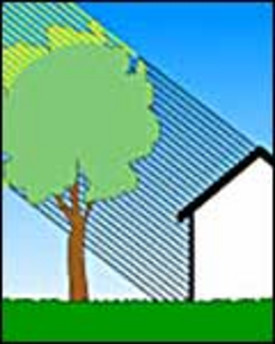 |
||||||
|
||||||
|
|
The sun is the source of a tremendous amount of heat energy. Therefore, the more sunlight hitting and entering a building in summer, the warmer that building will be and, therefore, the cost of air conditioning will be higher. The opposite is true of winter heating costs. In winter the sun is warming and welcome.
A simple way to block summer sun and admit winter sun is to plant a carefully placed deciduous tree, one that loses its leaves in autumn. It will provide shade in summer, and yet in winter the warming sun will pass through or under its leafless branches.
But proper placement is not so simple. The relation of earth and sun changes with the seasons. The earth revolves around the sun once each year. As it does so, first the northern, then the southern portion of the earth gets the direct rays of the sun. In summer, the northern hemisphere is toward the sun, so days are longer and the sun is higher in the sky. In winter, the converse is true.
To plan for the most efficient use of winter sunlight and warmth, you must first know the direction and lowest angles of the winter sun. Heat from winter sunlight is effective only between 9:00 A.M. and 3:00 P.M. So while the winter sunrise and sunset are interesting and beautiful, the important calculations concern only midday. For the summer calculation, however, you must make an exception for the late, low-angled western sun, which occurs during hot seasons. Deciduous trees are useful both for admitting rays of winter sun and for providing summer shade.
Evergreen plants may be used on the south side to screen or block a bad view, as long as they don’t grow so tall that they block the low angle of the desirable winter sun. On the north side, there is never any sun, so evergreens of any height may be used.
On the southern exposure, fences may also be used, their heights determined by the distance from the building. For instance, a 6-foot evergreen rhododendron or a 5-foot fence may be placed 20 feet in front of a sliding glass door with no loss of winter sun.
Obviously, the mature size of plants is a major consideration. Choosing the proper genetic variety, which will grow to the height you want, is as important as the calculations of where to place it. The more carefully you plan the planting, with attention to detail and nuance, the better it will function.
 |
||||||
|
||||||
|
|
Trees on the southern exposure have to shade only a small angle of high summer sun. For that reason, fast-growing, or columnar trees may be used. It is interesting to note that a tree 25 feet distant from a building must be over 50 feet tall to provide shade on the south side in summer. It takes a long time to grow a tree that tall. But if it’s planted 10 feet from the building, it needs to be only 25 feet tall.
In summer you’ll want trees on the western exposure to protect the house form the hot afternoon sun. In winter, no effective sun comes from that quarter, so those trees can be evergreen or deciduous.
The taller the trees, the better. They will shade not only the windows, but also the roof. Not, however, too near the foundation, please. The majestic trees we think of as “shade trees” would soon interfere with water pipes, foundations, landscape plantings, and gutters. Avoid planting any trees with invasive roots near a house — it’s just asking for trouble (this group includes poplars, aspens, elms, willows, oaks, and bamboos among others).
On the southern exposure, because the summer sun is high in the sky, lower branches are not needed for shade. Trees can be trained to grow tall, with high space under them. This treatment gives a feeling of spaciousness and opens a view. It takes several years to develop a high canopy of leaves, but in the end it is worth the effort.
Columnar, upright trees (such as Columnar Norway, red, or sugar maples, some poplar, cherry, and elm trees) function well on southern exposures because they naturally grow tall and not too wide. A clump or row of such trees, such as birch or flowering pear, is highly attractive. These narrow, upright trees are also useful in places where shade is needed but space is limited, such as courtyards or driveways. In the South, tall palm trees are successfully planted by nurseries for this purpose.
To get both summer shade and winter sun from the same tree takes a peck of planning. It also requires raising the branches to make a high canopy of leaves. In hot climates, tall evergreens may be used. In northern areas, deciduous trees should be used. (The rule of thumb is to lop off only two lower branches in any one year, until the desired 7-foot clear space is reached. It may take three or four years to achieve this.) In winter the low sun can enter windows underneath the raised canopy of branches.
Actually, leafless branches of deciduous trees can block out about 25 to 40 percent of the sun’s rays. Ideally, the thickest part of the branch structure should be at the tip where it will not block low winter sunlight to windows, even though some of the roof will not receive maximum winter warming. Most energy-conscious homeowners have heavy insulation under the roof, so the roof is not as important as the windows for benefiting from winter sun. Snow on the roof is an excellent natural insulator.
The EnergyWise House is an ongoing project that examines energy efficient building techniques, materials, and methods.
Credit: Energy Efficiency and Renewable Energy Clearinghouse




























